A battery that combines safety, longevity, and efficiency—this is what a LiFePO4 (Lithium Iron Phosphate) battery offers. Known for its robust thermal stability, it greatly reduces the risks associated with traditional batteries. But what sets it apart regarding performance and applications? Understanding its technical specifications and advantages can provide insights into why it may be the superior choice for your energy needs.
A Lithium Iron Phosphate (LiFePO4) battery is a type of rechargeable lithium-ion battery that utilizes iron phosphate as its cathode material, distinguishing it from other lithium-based batteries.
In your quest for reliable power solutions, understanding what a LiFePO4 battery entails is essential. Characterized by its robust safety features and long cycle life, it typically outlasts traditional lithium-ion and lead-acid batteries.
With a nominal voltage between 3.2-3.3 V, the LiFePO4 battery maintains a high charge efficiency and minimal self-discharge rates. Its ability to withstand harsh conditions makes it suitable for various applications.
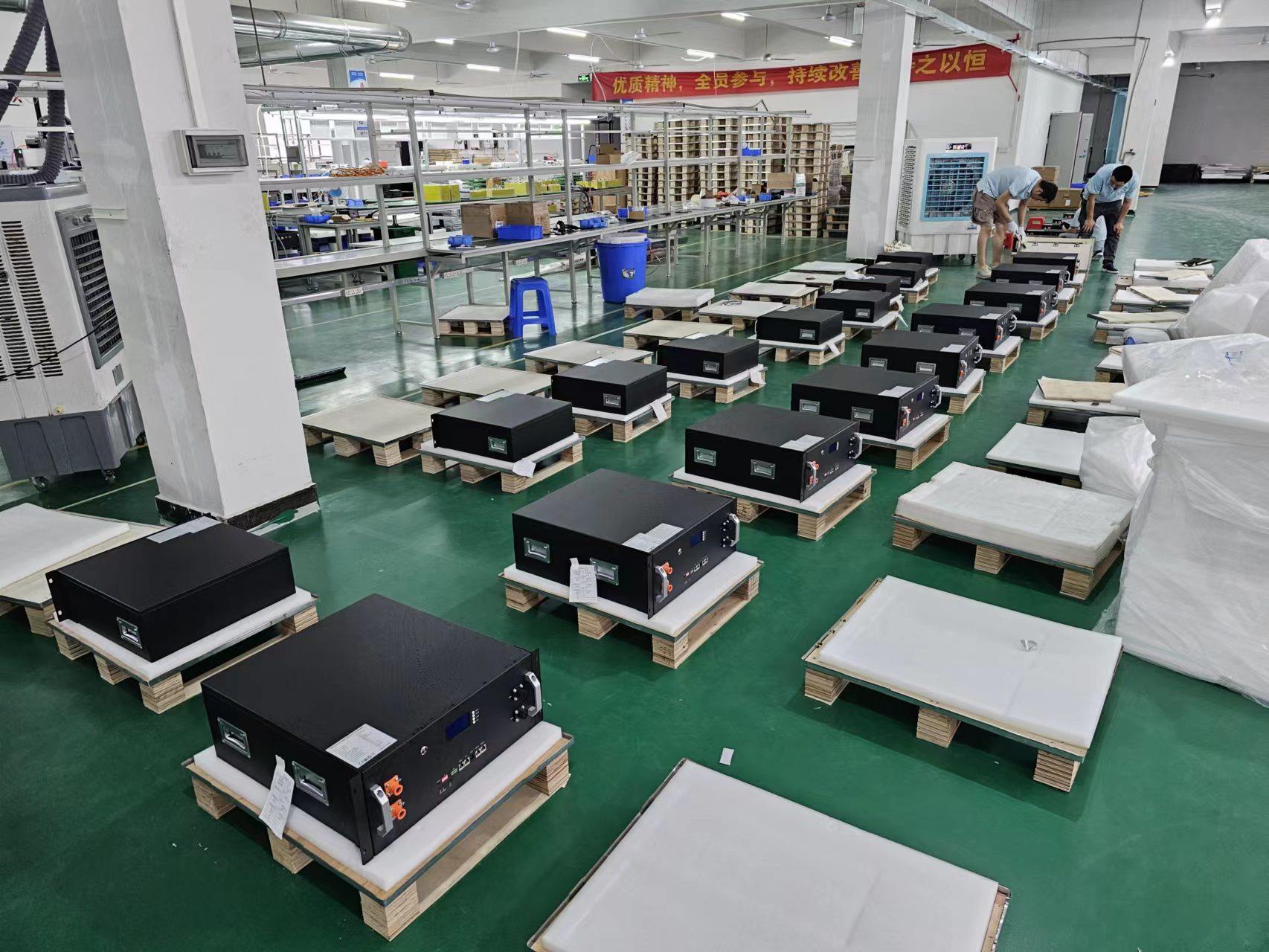
What is a lifepo4 battery's history? Initially developed in the late 1990s, LiFePO4 batteries emerged as a response to safety concerns associated with traditional lithium-ion batteries. Researchers aimed to create a more stable alternative, addressing issues like thermal runaway and combustibility. By utilizing lithium iron phosphate as the cathode material, they greatly improved safety profiles.
However, it's essential to acknowledge the lithium iron phosphate battery disadvantages; these include lower energy density compared to other lithium-ion variants and higher initial costs. Despite these drawbacks, the short history of LiFePO4 batteries illustrates their rapid adoption in various applications, driven by their longevity, safety, and minimal maintenance needs.
This innovation has paved the way for safer, more reliable energy storage solutions in diverse industries.
Why it can be accepted so quickly, the answer is easy. Technical specifications of Lithium Iron Phosphate (LiFePO4) batteries reveal their robust performance and reliability in various applications.
You’ll find that these batteries have an energy density ranging from 140 Wh/L to 330 Wh/L and a specific energy of 90 Wh/kg to 160 Wh/kg. Their nominal voltage is between 3.2-3.3 V, operating efficiently within temperatures of -20°C to 60°C.
With a cycle life exceeding 2,000 cycles, and now can be used more than 6000 times in recent years, they’re ideal for long-term use, making them the best LiFePO4 battery choice for renewable energy systems, electric vehicles, and backup power solutions.
Furthermore, their low self-discharge rate of 1-3% per month guarantees they maintain charge effectively. Understanding what a LiFePO4 battery is used for will help you maximize its advantages in your applications.
When considering Lithium Iron Phosphate (LiFePO4) batteries, you'll encounter distinct advantages and disadvantages that impact their usability.
Their robust safety profile and long lifespan make them appealing, but the higher initial cost and weight compared to other lithium options can be drawbacks.
What is a lifepo4 battery's advantages? Lithium Iron Phosphate (LiFePO4) batteries offer numerous advantages that make them a preferred choice in various applications. Their robust safety profile guarantees that lifepo4 batteries are safe due to their stable chemistry and incombustible nature. Additionally, they provide a long service life, superior thermal stability, and efficient charge/discharge cycles. You also benefit from a compact design that minimizes weight without sacrificing performance.
Even though Lithium Iron Phosphate (LiFePO4) batteries excel in many areas, they do come with some disadvantages that potential users should consider. So what is a lifepo4 battery's drawbacks?
One primary concern is their higher initial cost compared to traditional lead-acid batteries. This upfront investment can deter users, especially in budget-sensitive applications.
Additionally, LiFePO4 batteries have a lower energy density compared to other lithium-ion chemistries, resulting in larger physical sizes for the same capacity. And then they require minimal maintenance, the necessity for a Battery Management System (BMS) adds complexity and potential points of failure.
Understanding these limitations is essential for making informed decisions regarding their use in various applications.
As we mentioned in previous article, applications for Lithium Iron Phosphate (LiFePO4) batteries span a wide range of industries and uses due to their superior performance characteristics. You’ll find these batteries in renewable energy storage systems, electric vehicles, and portable power tools, where reliability and safety are paramount. Their lightweight and compact design make them ideal for applications requiring space efficiency.
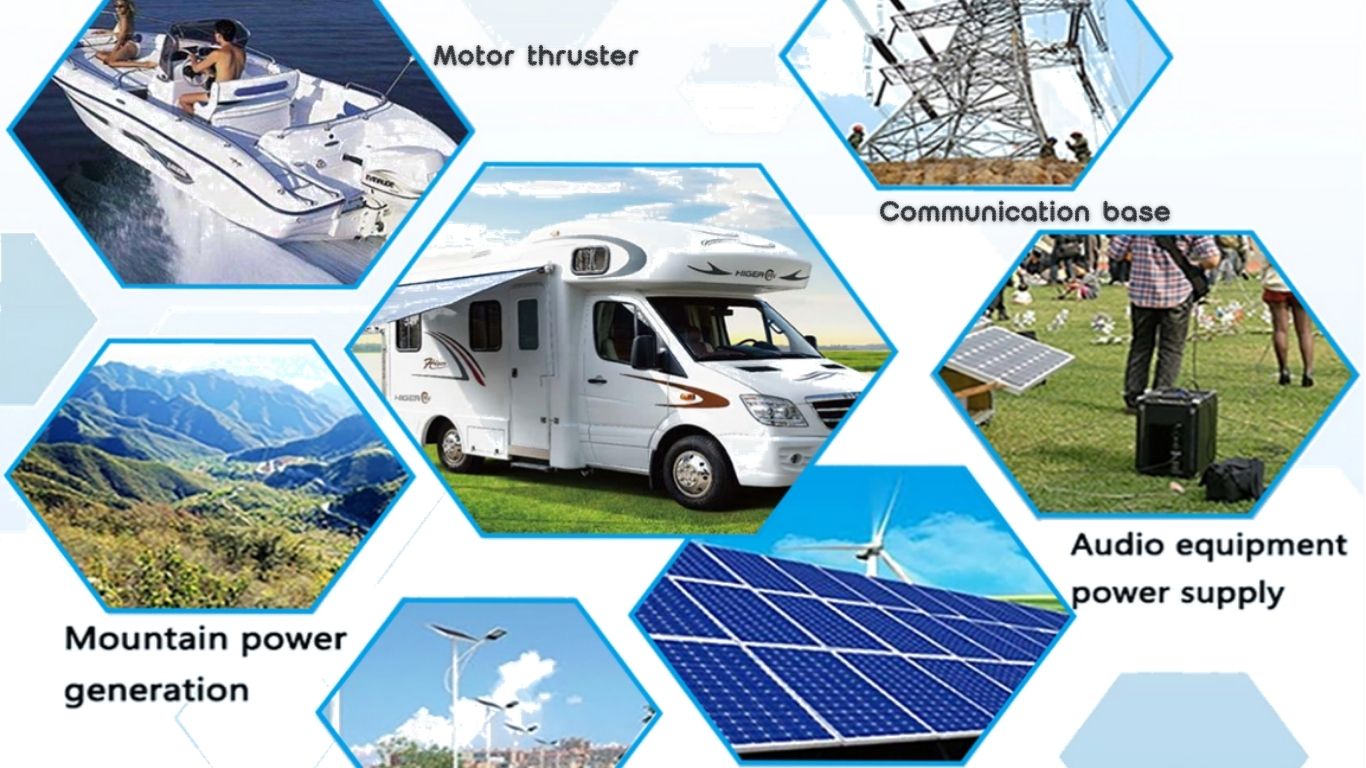
In each of these areas, LiFePO4 batteries provide peak performance, ensuring you have the power and reliability for demanding applications.
How safe are LiFePO4 batteries compared to other battery technologies? That's a good question.
LiFePO4 batteries excel in safety due to their stable chemistry and superior thermal stability. Unlike traditional lithium-ion batteries, they’re incombustible, minimizing the risk of thermal events during mishandling. This robustness allows them to tolerate harsh environments, including extreme temperatures, while considerably reducing fire hazards.
Additionally, integrating a Battery Management System (BMS) further enhances safety by monitoring charge and discharge processes, preventing overcharging and discharging.
To summarize, LiFePO4 batteries represent a highly safe option, mitigating risks associated with battery failures, thereby making them a reliable choice for various applications where safety is paramount.
Your confidence in these batteries is backed by their proven safety record and advanced technology.
What factors influence the lifespan of Lithium Iron Phosphate (LiFePO4) batteries?
Primarily, it’s the depth of discharge (DoD), operating temperature, and charging cycles. With a typical lifespan ranging from 5,000 to 10,000 cycles, LiFePO4 batteries excel under ideal conditions, maintaining performance even with 100% DoD.
Keeping temperatures within the -20°C to 60°C, employing a Battery Management System (BMS), such these steps could make your battery healthier.
Ultimately, your careful management of these factors will determine how long your LiFePO4 battery remains reliable and efficient, reinforcing its status as a superior investment in energy storage solutions.
LiFePO4 batteries considerably outperform many traditional battery technologies regarding environmental impact. They utilize non-toxic materials, eliminating the risks associated with heavy metals like lead and cobalt, commonly found in other batteries.
Their chemical stability minimizes the likelihood of hazardous leaks during use or disposal, contributing to safer recycling processes. Unlike lead-acid batteries, which pose significant environmental hazards due to degradation, LiFePO4 batteries present a lower ecological footprint. If you want to know more about the different between lead- acid vs Lithium, you can move to our previous article.
Additionally, the absence of rare earth metals further reduces resource extraction impacts. As a user-focused solution, choosing LiFePO4 batteries means investing in a cleaner, more sustainable energy future, aligning your needs with environmental stewardship while maintaining high performance and safety standards.
Choosing Lithium Iron Phosphate batteries requires careful consideration of several key factors to confirm you're getting the best value for your investment. What is a lifepo4 battery's key factor to consider:
First, assess the capacity, which influences how much energy you can store and use, measured in Watt hours (Wh).
Next, prioritize longevity; while the initial cost may be higher, LiFePO4 batteries outlast lead-acid counterparts, offering significant savings over time.
Evaluate the depth of discharge (DoD) as LiFePO4 batteries can be fully utilized, unlike lead-acid models with limited capacity.
Additionally, check for a robust Battery Management System (BMS) that enhances safety and performance.
Finally, research different manufacturers to confirm you're selecting a high-quality product that aligns with your specific needs and applications.
By now, are you also a little troubled? There are so many things to consider. But don't worry. We'll list a few important part to help you understand.
Battery life is an essential factor to take into account in selecting Lithium Iron Phosphate batteries, as it directly impacts both performance and long-term savings. When evaluating options, consider the following aspects:
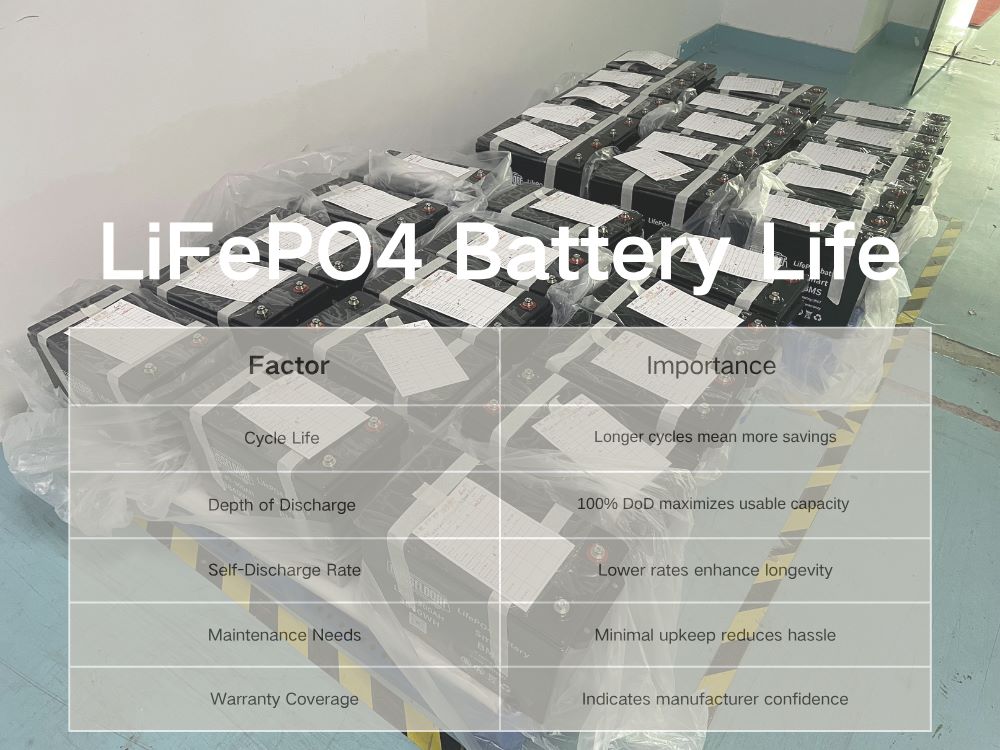
Choosing a LiFePO4 battery with extended cycle life and low self-discharge provides better reliability. Prioritize brands with strong warranties and minimal maintenance requirements to guarantee you're making a smart investment for your energy needs.
A solid warranty is essential for selecting Lithium Iron Phosphate (LiFePO4) batteries, as it reflects the manufacturer's confidence in their product's durability and performance.
When evaluating warranties, consider these key aspects:
A thorough warranty not only indicates confidence in product longevity but also safeguards your investment. Look for warranties that extend beyond five years, as this suggests the battery can withstand prolonged use.
Therefore, you need to opt for manufacturers that provide transparent warranty processes and responsive customer support. By prioritizing these factors, you guarantee a well-informed decision, maximizing your LiFePO4 battery's performance and lifespan.
Although cold weather can greatly impact battery performance, choosing the right Lithium Iron Phosphate (LiFePO4) battery can mitigate these effects.
When selecting a LiFePO4 battery for cold weather usage, consider the following factors:
Selecting a Lithium Iron Phosphate (LiFePO4) battery equipped with an effective Battery Management System (BMS) is essential for maximizing performance and safety. A robust BMS guarantees ideal charging and discharging, preventing damage from overvoltage and undervoltage conditions. When choosing a LiFePO4 battery, consider these key factors:
| Feature | Importance | Benefits |
| Voltage Regulation | Prevents overcharging | Extends battery lifespan |
| Temperature Control | Maintains safe operation | Enhances safety |
| Cycle Monitoring | Tracks performance | Informs maintenance needs |
| Protection Circuit | Safeguards against surges | Reduces risk of failures |
| Data Display | Provides real-time stats | Increases operational control |
Understanding these features will empower you to make informed choices, guaranteeing reliability and efficiency in your applications.
Understanding battery venting is essential for safety, especially in traditional batteries where gas buildup can lead to dangerous situations.
In contrast, LiFePO4 batteries greatly reduce this risk due to their stable chemistry and incombustible nature, often eliminating the need for venting altogether.
As battery systems operate, gases can accumulate due to chemical reactions, necessitating venting to prevent dangerous pressure build-up, particularly in traditional lead-acid and nickel-based batteries.
Here are key reasons why venting is crucial:
In contrast, LiFePO4 batteries typically don't require venting due to their stable chemistry, reducing the risk of gas accumulation and enhancing safety. However, if you live in a hot, humid area, it is important to keep the battery ventilated to ensure safe operation.
LiFePO4 batteries represent a significant advancement in battery technology, particularly when it comes to safety. Unlike traditional lithium-ion batteries, they feature a stable chemistry that minimizes thermal events, reducing the risk of fire.
Their incombustible nature allows them to withstand harsh conditions without compromising safety. In contrast, conventional batteries often require venting due to gas buildup, posing hazards during mishandling or failure. LiFePO4 designs eliminate this concern, offering peace of mind.
Additionally, their superior thermal and chemical stability guarantees consistent performance across various temperatures. By choosing LiFePO4, you gain control over safety and efficiency, making it a smart alternative for demanding applications.
This combination of reliability and safety positions LiFePO4 as the future of battery technology.
When considering the installation of LiFePO4 batteries, it's important to assess several key factors that can greatly impact performance and longevity.
Here are four vital considerations:
To guarantee peak performance and longevity of your LiFePO4 battery, regular maintenance is essential.
First, confirm connections are clean and secure to prevent resistance buildup, which can impede performance. Monitor the battery’s voltage and temperature periodically; consistent readings outside the specified range can indicate issues.
While LiFePO4 batteries require minimal maintenance, it’s vital to avoid discharging below 20% state of charge to enhance lifespan. Keep your battery stored in a cool, dry place, as extreme temperatures can affect performance and safety.
Additionally, if your battery includes a Battery Management System (BMS), regularly check its functionality to verify it effectively manages charging and discharging cycles.
Following these steps will help you maximize your investment in LiFePO4 technology.
Understanding the various types of LiFePO4 batteries is important for selecting the right one for your specific application. Here are four common types to evaluate:
Choosing the right type will enhance performance and longevity, ensuring your investment meets your specific energy demands effectively.
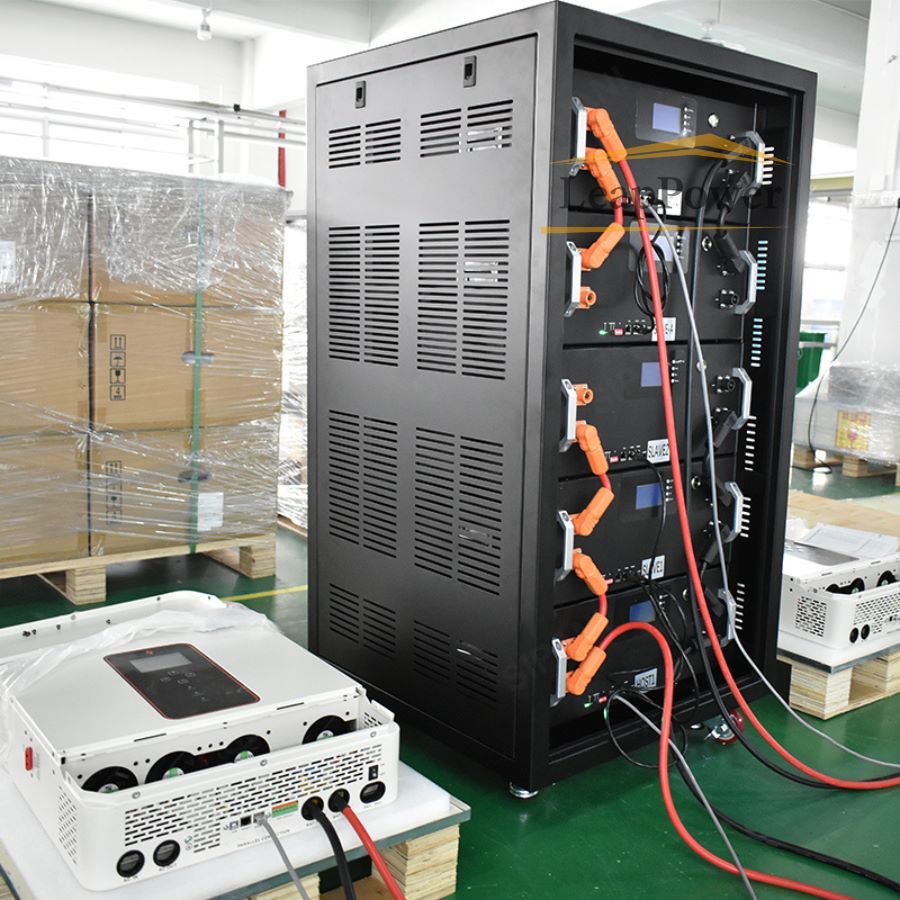
Selecting a good Battery Management System (BMS) for your LiFePO4 battery pack is vital, as it directly impacts the battery's safety, longevity, and performance.
Look for a BMS that offers overcharge and over-discharge protection, ensuring the battery operates within safe limits. It should also include cell balancing features to maintain uniform charge levels across all cells, enhancing lifespan.
Real-time monitoring capabilities, such as voltage, current, and temperature readings, are essential for proactive management. Additionally, consider a BMS with communication protocols like CAN or RS232 for seamless integration with your systems.
A reliable BMS minimizes risks, maximizes efficiency, and allows you to maintain control over your energy storage solution, ensuring peak performance throughout the battery's lifecycle.
Yes, you can use LiFePO4 batteries in electric vehicles. Their superior thermal stability, long cycle life, and high discharge efficiency make them an excellent choice for powering vehicles, enhancing performance while ensuring safety and longevity.
For ideal charging of LiFePO4 batteries, use a constant current/constant voltage (CC/CV) method. Set the current to 0.5C, and charge until the voltage reaches 3.65V per cell, ensuring efficient and safe charging.
Temperature extremes can greatly impact your LiFePO4 battery's performance. At high temperatures, you risk reduced lifespan and efficiency, while low temperatures can lead to diminished capacity and slower charging rates. Maintaining ideal conditions guarantees reliable operation.
Yes, there are recycling programs for LiFePO4 batteries. Many manufacturers and organizations facilitate recycling to recover valuable materials, ensuring environmental sustainability. You should check local facilities or manufacturer guidelines for specific recycling options.
Advancements in LiFePO4 battery technology focus on enhancing energy density, reducing production costs, and improving thermal management. You’ll find innovations like faster charging capabilities and integration with smart technologies for better performance and efficiency in various applications.
In summary, Lithium Iron Phosphate (LiFePO4) batteries represent a significant advancement in energy storage technology, combining safety, efficiency, and longevity. With a cycle life of over 6,000 charge-discharge cycles, they outlast many conventional batteries, making them a smart investment for both personal and commercial use. As the demand for sustainable energy solutions grows, LiFePO4 batteries are positioned to play an essential role in the future of power storage, supporting everything from electric vehicles to renewable energy systems.


About Our Mission:
"We strive to deliver real value for our customers through distinctive design, superb quality and excellent customer service at prices that reflect the real worth of our products."


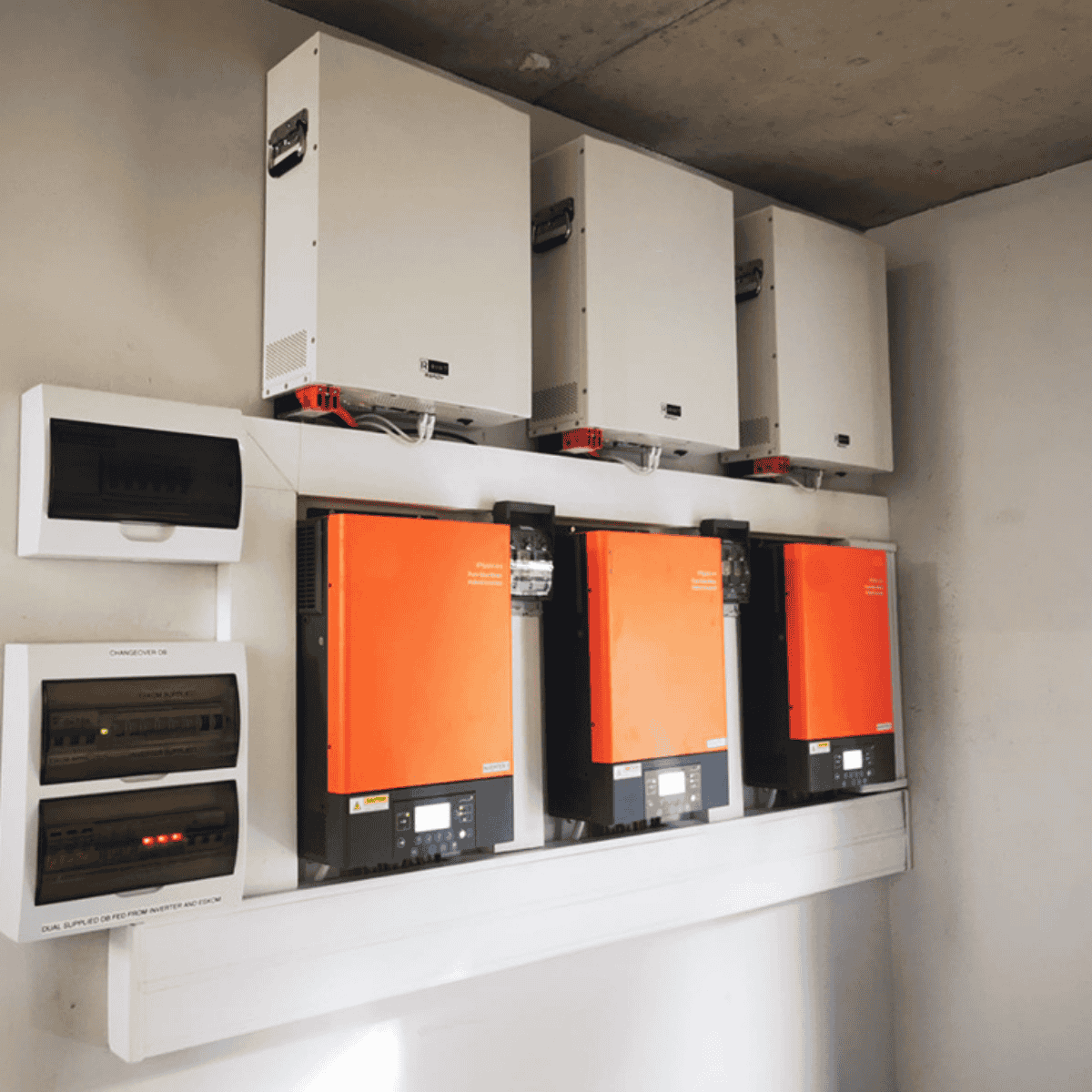

[…] Lithium ion batteries […]
[…] What are LiFePO4 Batteries? […]